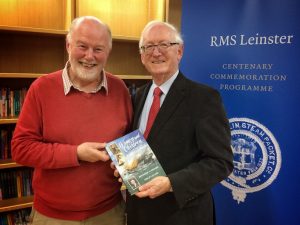On 10 October 1918 RMS Leinster, the mailboat from Kingstown (Dún Laoghaire) to Holyhead in Wales, was sunk by a German submarine UB-123 with the loss of 564 lives, the greatest loss of life in a single event in the Irish Sea. At the time the mail boat was carrying 803 persons – 75 crew, 22 postal sorters, 200 civilians and 506 military personnel. Among the dead were nine Australian military personnel about whom I wrote in Anzacs and Ireland – seven serving with the AIF, one with the NZEF and a nurse serving with a NZ military hospital.
In October 2018 the centenary of the loss of the Leinster, which occurred just a month before the end of the war, was commemorated by a number of events in Dún Laoghaire, including a state function at Moran Park attended by the Minister for Culture, Heritage and the Gaeltacht and by the First Minister of Wales, as well as ambassadors from Britain, Australia and Canada and the US Chargé d’Affaires. In the busy program marking the Decade of Centenaries currently being commemorated in Ireland, much of the credit for including the sinking of RMS Leinster is due to local historian Philip Lecane. Philip first became interested in the tragedy in the 1990s and was involved with the commemorations in 2003 for the 85thanniversary, when it was rescued from the obscurity into which it had descended during the period of Ireland’s ‘social amnesia’ concerning the First World War. Since then Philip has undertaken detailed research into the sinking and in particular into the lives of the people who were on board the ship. As a result, he has built up a vast network across the globe of family members of those on the Leinster and of historians and other interested persons, thus giving the sinking a sufficiently high profile to convince the Irish government to include it in its commemorative program for 2018.
Other commemorative events included a seminar on 9 October hosted by the National Maritime Museum of Ireland and attended by about 80 people from Ireland, Australia, Canada and the United States, mostly family members. In addition to Philip Lecane, the speakers were local historian Lucille Ellis, the Royal Irish Academy’s Dr Michael Kennedy, An Post historian Stephen Ferguson, RMS Leinster relative Andrea Ward and myself. I spoke about the Australians on board the Leinster in a paper entitled “They Came from a Land Downunder“.
After the seminar I had the honour of launching Philip Lecane’s latest book, Women and Children of RMS Leinster: Restored to History, which provides fascinating detail concerning the 127 women and 27 children who were on the Leinster that day, most of whom (93 and 21) did not survive. This book follows on from Philip’s 2005 book describing the tragedy itself: Torpedoed!: The RMS Leinster Disaster. Numerous other events marked the centenary, including a History Ireland Hedge School in which I participated and a dramatized account of the tragedy, Fatal Voyage, told through music and dramatic readings at the Pavilion Theatre, and a tour to visit RMS Leinster graves in Grangegorman Military Cemetery, among which are the graves of five of the Australians (four AIF and one NZEF) whose bodies were recovered.
Details of the commemorative events are listed in the official Calendar of Events.

